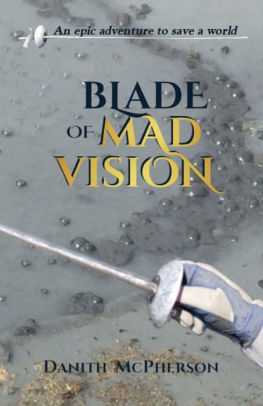Book Review: Blade of Mad Vision by Danith McPherson
Austin Swiftbrooke’s sister Skylar disappeared two years ago on the planet Callister. Practicing his fencing alone in the natural “arena” near the human colony without her seems hollow, but is a connection to her, and a way of showing he hasn’t given up hope Skylar’s alive. When a strange little man named Ko Lian Po appears and offers to take Austin to his sister, the boy agrees despite his misgivings.

It’s at this point that some monsters show up. As a result, Ko Lian Po is forced to open a gateway further away from Skylar than he had intended, and a much longer voyage is started. It is eventually explained that they are on the parallel world Saffrian. Most of its technological development appears to be at a medieval level, though there are hints that it once was more machine-oriented before a disaster called the Separation occurred. There’s a thriving subculture of competitive swordplay, and artists have an elevated status.
The latter turns out to be because artists tend to have precognitive abilities in this world, creating art that foretells events to be brought about or forestalled. Skylar, as it happens, looks very much like one such artist, Cabrill. Cabrill is on the run from the Art Guild as it’s feared that her visions have driven her mad, and from the lord Kriken, who wants her to solve a crisis in his fiefdom at the cost of her freedom. Skylar is currently impersonating Cabrill in an effort to allow the artist to have enough time to figure out what her artworks truly mean.
Ko Lian Po has fetched Austin not just because Skylar would like to see him again, but because a figure that looks just like Austin appears in Cabrill’s artwork and is presumably key to solving the upcoming crisis.
This small press science fiction novel falls mostly into the young adult category due to the age of the primary protagonists and its themes. There are chapters from other viewpoints to fill in some background details (I like the self-centered fellow who’s stuck in charge of the asylum for mad artists.)
The art creation segments are interesting and varied. It’s fairly obvious though that the writer wrote large sections of this work to reflect an interest in modern fencing. We get a little bit of Austin having to adjust to the more rounded sword combat of Saffrian, only to get matters arranged so that the locals have to play more or less by his rules instead. And the final confrontation is specifically designed to play into the specific kind of swordplay he and Skylar practice.
There’s a lot of world and characters crammed in, and much of it gets short shrift as this is a standalone book. Once the actual villain of the book finally shows up, explanations and motivations are rushed for the big combat scene.
Perhaps the biggest question bandied about but never quite answered is whether the artists’ visions and works create the future, or are created by the future. Certain segments seem railroaded.
There is plenty of room in the setting for other works, though probably not with the same main characters.
Recommended for young adults with an interest in fencing.

